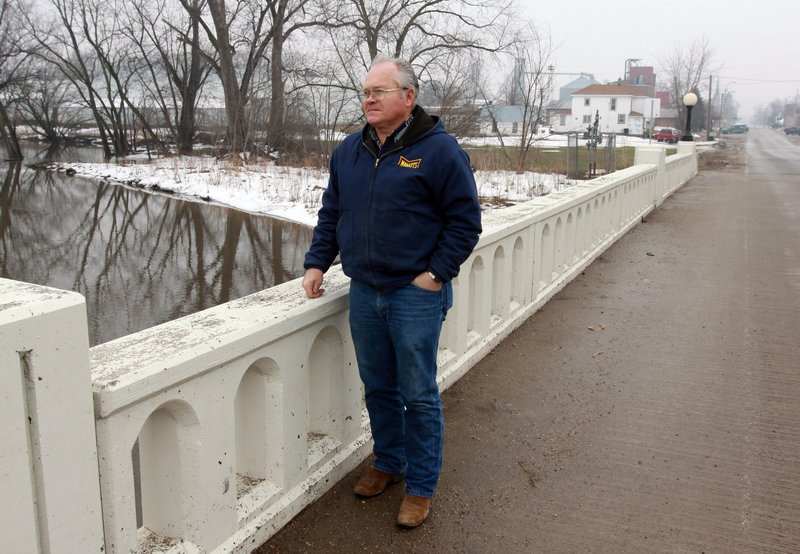CHELSEA, Iowa — Two years ago, Larry Frese thought he’d escaped the worst of a flood that had left a lot of his neighbors’ homes and a large swath of Iowa underwater, even as overflowing Otter Creek lapped at his garage door.
“Then all of a sudden — BANG!” said Frese, recalling the sound of the garage door buckling before the muddy water rushed in. “Here comes the refrigerator bouncing by. Man, that was sickening.”
It wasn’t the first time his home was flooded and it probably won’t be the last. But Frese and his neighbors in tiny Chelsea are not interested in being bought out of their homes by the government for the chance start over on higher ground. Neither do handfuls of other flood-prone Midwest towns caught in a cycle of flood and rebuild.
“I love this town too much to leave,” the 69-year-old tavern owner said.
FIGHTING A LOSING BATTLE
Many mitigation experts say such buyouts are the most cost-effective way of fighting floods in the most at-risk areas. The government buys homes in these areas and tears them down, replacing them with green space, parks or wildlife refuges. When the next flood comes, taxpayers don’t have to pay for sandbagging, emergency shelters, rescues or cleanup.
But such buyouts are voluntary, and despite the clear benefits they’ve bought some flood-beleaguered towns that opted in, many communities refuse to budge — content to fight a losing battle against flooding every few years and rebuild.
“It’s a big benefit to the nation when you don’t have to come back the next time and the next time and the next time,” said Larry Larson, director of the Association of Floodplain Managers.
Battling floods is expensive, but how expensive isn’t clear. The Federal Emergency Management Administration was unable to say how much the government has spent fighting floods and cleaning up afterward since a massive flood that devastated a large swath of the Midwest in 1993. Experts estimate the cost at several billion dollars.
MARK TWAIN’S HOMETOWN
According to a 2005 study the independent Multihazard Mitigation Council conducted for Congress, every dollar spent on disaster mitigation saves $4 in future costs. In the case of floods, most of that money spent on mitigation would go for buyouts.
The government generally doesn’t pay to rebuild damaged homes in flood plains — homeowners or their insurers do. Those living in the most flood-prone areas who have federally backed mortgages and whose communities participate in the National Flood Insurance Program are required to purchase flood policies. The policies are sold through private insurers but are heavily subsidized by the government. A few private companies also offer policies.
But if a disaster is declared, some federal aid may be available for repairs. Low-interest loans may be offered through the Small Business Administration, and FEMA may provide temporary housing or rental assistance for flood victims.
FEMA introduced its buyout program after the 1993 flood. The program has been undeniably beneficial to several Missouri towns that have taken part.
After the 1993 flood, 116 homes in Mark Twain’s Mississippi River hometown of Hannibal were bought out.”In Missouri, it seems that buyouts have worked the best and been the most cost-effective approach,” said Sheila Huddleston, the state’s hazard mitigation officer.
TOWN NOT INTERESTED
But some communities want no part of it.
Chelsea’s 297 residents were tempted to move after 2008’s flood but ultimately opted to stay put. Municipal leaders considered a plan to move their town, in the northern part of the state between the Iowa River and Otter Creek, to a nearby hill. But the plan was scrapped when the farmer who owned the land decided not to sell.
Mayor Roger Ochs, then a councilman, didn’t like what he saw as people argued over whether to move or not, argued over the value of their property. “It was neighbor against neighbor,” he said. “It nearly tore the town apart.”
Floods are a way of life in Chelsea, and at the Silver Dollar, Frese’s tavern on the town’s mostly deserted main street, black and white photos from past floods line the walls. Industry dried up years ago, but residents say it’s their home and they wouldn’t have it any other way.
Copy the Story Link
Send questions/comments to the editors.



Success. Please wait for the page to reload. If the page does not reload within 5 seconds, please refresh the page.
Enter your email and password to access comments.
Hi, to comment on stories you must . This profile is in addition to your subscription and website login.
Already have a commenting profile? .
Invalid username/password.
Please check your email to confirm and complete your registration.
Only subscribers are eligible to post comments. Please subscribe or login first for digital access. Here’s why.
Use the form below to reset your password. When you've submitted your account email, we will send an email with a reset code.